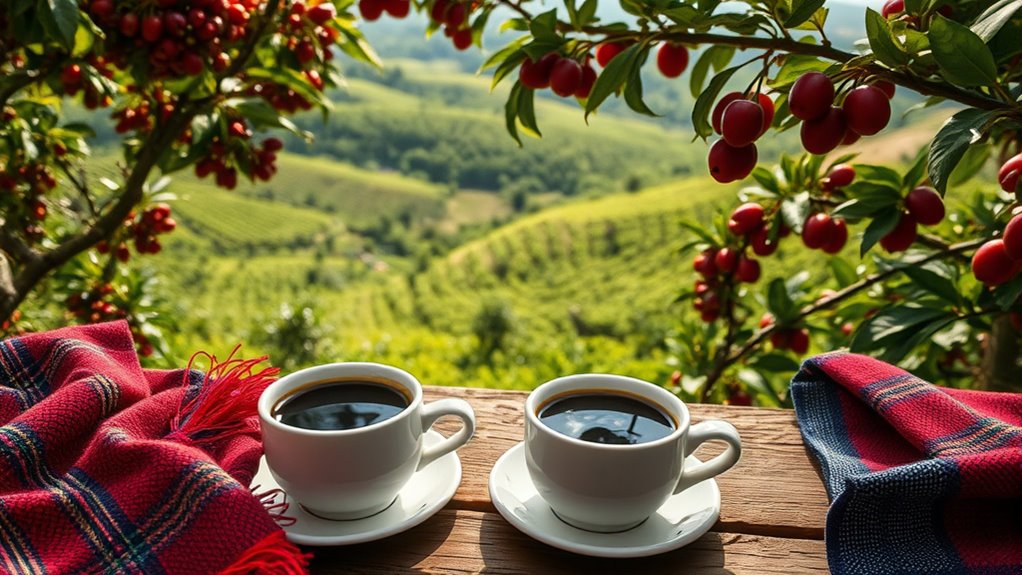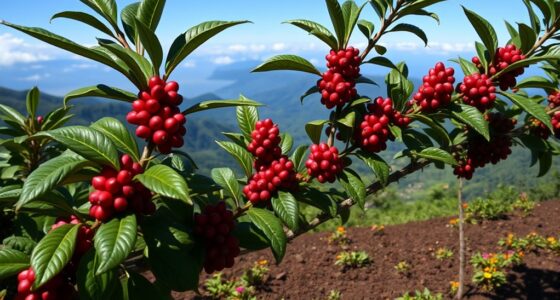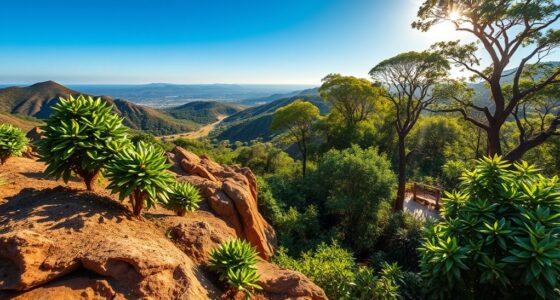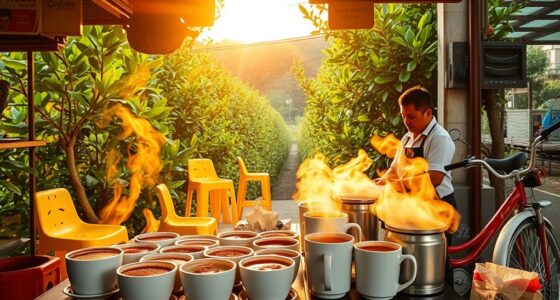In Mexico, coffee from Chiapas to Veracruz is more than a drink—it’s a cherished tradition rich in regional flavors and cultural rituals. You’ll find that local farmers carefully harvest beans, preserving unique processing methods that highlight each area’s distinct characteristics. Brewing styles, like the popular “cafetera,” reflect deep-rooted techniques, while coffee rituals serve as symbols of hospitality and community. Exploring these vibrant customs reveals the true spirit of Mexican coffee—there’s much more to uncover.
Key Takeaways
- Coffee in Mexico symbolizes tradition, community, and regional pride, especially in Chiapas and Veracruz.
- Traditional processing methods preserve unique flavors influenced by local soil and climate.
- Brewing techniques like “cafetera” and pour-over reflect regional diversity and cultural heritage.
- Coffee rituals are integral to daily life, emphasizing slow, deliberate preparation as a sign of hospitality.
- Mexico’s coffee farming supports local economies and showcases regional flavors and craftsmanship.
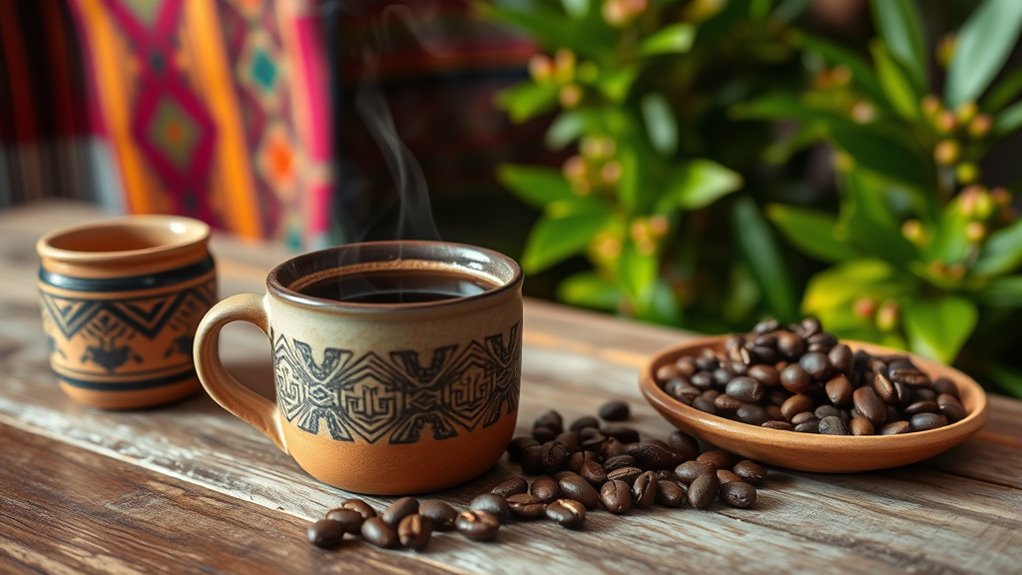
Have you ever wondered why coffee holds such a special place in Mexico’s culture? It’s because coffee isn’t just a beverage here—it’s a symbol of tradition, community, and regional pride. From the lush slopes of Chiapas to the vibrant plantations of Veracruz, coffee cultivation plays a central role in many local economies and daily routines. You might not realize it, but the way coffee is grown in Mexico is a careful balance of climate, altitude, and local expertise. Coffee farmers often work tirelessly, selecting the best beans and nurturing them from seed to harvest. These beans are then processed with traditional methods that preserve their unique flavors, which vary depending on the region’s soil and weather conditions. Once harvested, the journey continues into the domain of brewing techniques, which are just as diverse as the landscapes themselves. Interestingly, the regional differences in processing and brewing further highlight Mexico’s rich coffee heritage. In Mexico, brewing coffee isn’t just about making a quick cup; it’s about honoring centuries-old methods. Many locals still prefer using the traditional “cafetera,” a small stovetop espresso maker, which produces a concentrated, rich brew that captures the essence of Mexican coffee. Others enjoy the pour-over method, allowing for a more delicate extraction of flavors. Regardless of the technique, the process is often slow and deliberate, emphasizing the importance of quality over speed. This attention to detail reflects a cultural appreciation for coffee as a ritual—something to be savored and shared. You might notice that in many Mexican households, coffee is brewed fresh in the morning or during gatherings, serving as a warm symbol of hospitality.
Frequently Asked Questions
How Does Mexican Coffee Cultivation Impact Local Ecosystems?
You might wonder how Mexican coffee cultivation affects local ecosystems. Sustainable farming practices can help protect biodiversity, ensuring native plants and wildlife thrive alongside coffee production. When farmers avoid harmful chemicals and preserve natural habitats, they support biodiversity conservation. By choosing eco-friendly methods, you contribute to maintaining healthy ecosystems, preventing deforestation, and promoting long-term environmental balance, all of which benefit local communities and the global climate.
What Are Traditional Mexican Coffee Brewing Methods?
Your curiosity about traditional Mexican coffee brewing methods is like opening a treasure chest of cultural richness. You’ll discover that traditional brewing often involves methods like using a chorreador, a cloth filter, or a clay pot called a olla de barro, which highlight local craftsmanship. While modern techniques like espresso machines are gaining popularity, the authentic experience remains rooted in these time-honored practices that preserve Mexico’s coffee heritage.
How Do Indigenous Communities Participate in Coffee Production?
You can see indigenous communities actively participating in coffee production through their use of indigenous knowledge, which guides sustainable farming and traditional processing methods. They often work within community cooperatives, strengthening local economies and preserving cultural practices. By participating in every stage—from planting to harvesting—you support their efforts to maintain their heritage and guarantee fair trade, helping to sustain their communities and the environment.
What Are the Economic Challenges Faced by Mexican Coffee Farmers?
You face economic challenges like market fluctuations and limited farming subsidies that threaten your livelihood. These issues cause income instability, making it hard to plan for the future, invest in better practices, or improve quality. You also struggle with low prices that don’t cover costs, and insufficient government support that leaves you vulnerable. Overcoming these obstacles requires stronger policies, fairer market access, and sustainable solutions to secure your coffee farming future.
How Is Mexican Coffee Integrated Into Cultural Festivals and Rituals?
You’ll find that Mexican coffee is deeply woven into cultural festivals and rituals, highlighting its significance in daily life. Coffee and art often come together in vibrant displays, showcasing local craftsmanship. Additionally, coffee and spirituality play an essential role, with ceremonies honoring its cultural importance. These traditions celebrate coffee’s heritage, fostering community and preserving age-old customs that connect people to their roots.
Conclusion
So, next time you sip that steaming cup of Mexican coffee, remember it’s more than just a pick-me-up. From the lush hills of Chiapas to Veracruz’s coastal plantations, centuries of tradition brew into your mug—yet, all that effort often goes unnoticed. Ironically, while you enjoy your rich, flavorful coffee, the very land and people behind it might be longing for recognition. Cheers to savoring a drink that’s truly a world of stories in every drop.
